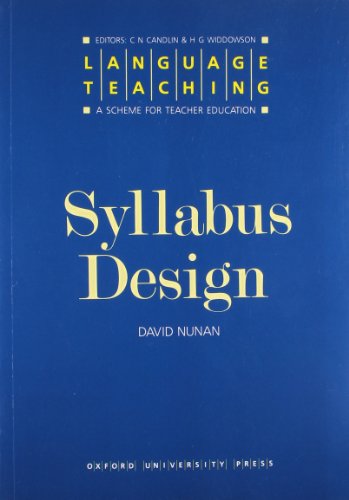
Sinossi
Syllabus Design demonstrates, in a practical way, the principles involved in planning and designing an effective syllabus. It examines important concepts such as needs analysis, goal-setting, and content specification, and serves as an excellent introduction for teachers who want to gain a better understanding of syllabus design in order to evaluate, modify, and adapt the syllabuses with which they work.
Le informazioni nella sezione "Riassunto" possono far riferimento a edizioni diverse di questo titolo.
Descrizione del libro
Lengua extranjera: inglés.Inglés. Material Complementario.
Contenuti
- The author and series editors
- Introduction
- Section One: Defining syllabus design
- 1 The scope of syllabus design:
- 1.1 Introduction:
- 1.2 A general curriculum model:
- 1.3 Defining 'syllabus':
- 1.4 The role of the classroom teacher:
- 1.5 Conclusion:
- 2 Points of departure:
- 2.1 Introduction:
- 2.2 Basic orientations:
- 2.3 Learning purpose:
- 2.4 Learning goals:
- 2.5 Conclusion:
- 3 Product-oriented syllabuses:
- 3.1 Introduction:
- 3.2 Analytic and synthetic syllabus planning:
- 3.3 Grammatical syllabuses:
- 3.4 Criticizing grammatical syllabuses:
- 3.5 Functional-notional syllabuses:
- 3.6 Criticizing functional-notional syllabuses:
- 3.7 Analytic syllabuses:
- 3.8 Conclusion:
- 4 Process-oriented syllabuses:
- 4.1 Introduction:
- 4.2 Procedural syllabuses:
- 4.3 Task-based syllabuses:
- 4.4 Content syllabuses:
- 4.5 The natural approach:
- 4.6 Syllabus design and methodology:
- 4.7 Grading tasks:
- 4.8 Conclusion:
- 5 Objectives:
- 5.1 Introduction:
- 5.2 Types of objective:
- 5.3 Performance objectives in language teaching:
- 5.4 Criticizing performance objectives:
- 5.5 Process and product objectives:
- 5.6 Conclusion:
- Section Two: Demonstrating syllabus design
- 6 Needs and goals:
- 6.1 Introduction:
- 6.2 Needs analysis:
- 6.3 From needs to goals:
- 6.4 Conclusion:
- 7 Selecting and grading content:
- 7.1 Introduction:
- 7.2 Selecting grammatical components:
- 7.3 Selecting functional and notional components:
- 7.4 Relating grammatical, functional, and notional components:
- 7.5 Grading content:
- 7.6 Conclusion:
- 8 Selecting and grading learning tasks:
- 8.1 Introduction:
- 8.2 Goals, objectives, and tasks:
- 8.3 Procedural syllabuses:
- 8.4 The natural approach:
- 8.5 Content-based syllabuses:
- 8.6 Levels of difficulty:
- 8.7 Teaching grammar as process:
- 8.8 Conclusion:
- 9 Selecting and grading objectives:
- 9.1 Introduction:
- 9.2 Product-oriented objectives:
- 9.3 Process-oriented objectives:
- 9.4 Conclusion:
- Section Three: Exploring syllabus design
- 10 General principles:
- 10.1 Curriculum and syllabus models:
- 10.2 Purposes and goals:
- 10.3 Syllabus products:
- 10.4 Experiential content:
- 10.5 Tasks and activities:
- 10.6 Objectives:
- Glossary
- Further reading
- Bibliography
- Acknowledgements
Le informazioni nella sezione "Su questo libro" possono far riferimento a edizioni diverse di questo titolo.
Risultati della ricerca per Syllabus Design
Language Teaching. A Scheme for Teacher's Education. Syllabus Design (Language Teaching, a Scheme for Teacher Education)
Da: BooksRun, Philadelphia, PA, U.S.A.
Paperback. Condizione: Fair. First Edition. The item might be beaten up but readable. May contain markings or highlighting, as well as stains, bent corners, or any other major defect, but the text is not obscured in any way. Codice articolo 0194371395-7-1
Compra usato
Quantità: 1 disponibili
Language Teaching. A Scheme for Teacher's Education. Syllabus Design (Language Teaching, a Scheme for Teacher Education)
Da: Wonder Book, Frederick, MD, U.S.A.
Condizione: Good. Good condition. A copy that has been read but remains intact. May contain markings such as bookplates, stamps, limited notes and highlighting, or a few light stains. Codice articolo O05H-01803
Compra usato
Quantità: 1 disponibili
Syllabus Design
Da: ThriftBooks-Dallas, Dallas, TX, U.S.A.
Paperback. Condizione: Good. No Jacket. Pages can have notes/highlighting. Spine may show signs of wear. ~ ThriftBooks: Read More, Spend Less. Codice articolo G0194371395I3N00
Compra usato
Quantità: 1 disponibili
Syllabus Design
Da: ThriftBooks-Atlanta, AUSTELL, GA, U.S.A.
Paperback. Condizione: Good. No Jacket. Former library book; Pages can have notes/highlighting. Spine may show signs of wear. ~ ThriftBooks: Read More, Spend Less. Codice articolo G0194371395I3N10
Compra usato
Quantità: 1 disponibili
Syllabus Design
Da: ThriftBooks-Dallas, Dallas, TX, U.S.A.
Paperback. Condizione: As New. No Jacket. Pages are clean and are not marred by notes or folds of any kind. ~ ThriftBooks: Read More, Spend Less. Codice articolo G0194371395I2N00
Compra usato
Quantità: 1 disponibili
Syllabus Design
Da: ThriftBooks-Reno, Reno, NV, U.S.A.
Paperback. Condizione: Good. No Jacket. Pages can have notes/highlighting. Spine may show signs of wear. ~ ThriftBooks: Read More, Spend Less. Codice articolo G0194371395I3N00
Compra usato
Quantità: 1 disponibili
Syllabus Design
Da: ThriftBooks-Atlanta, AUSTELL, GA, U.S.A.
Paperback. Condizione: Good. No Jacket. Pages can have notes/highlighting. Spine may show signs of wear. ~ ThriftBooks: Read More, Spend Less. Codice articolo G0194371395I3N00
Compra usato
Quantità: 1 disponibili
Syllabus Design
Da: ThriftBooks-Dallas, Dallas, TX, U.S.A.
Paperback. Condizione: Fair. No Jacket. Readable copy. Pages may have considerable notes/highlighting. ~ ThriftBooks: Read More, Spend Less. Codice articolo G0194371395I5N00
Compra usato
Quantità: 1 disponibili
Syllabus Design
Da: ThriftBooks-Phoenix, Phoenix, AZ, U.S.A.
Paperback. Condizione: Good. No Jacket. Pages can have notes/highlighting. Spine may show signs of wear. ~ ThriftBooks: Read More, Spend Less. Codice articolo G0194371395I3N00
Compra usato
Quantità: 1 disponibili
Language Teaching: Syllabus Design
Da: Better World Books, Mishawaka, IN, U.S.A.
Condizione: Good. Used book that is in clean, average condition without any missing pages. Codice articolo 320052-6
Compra usato
Quantità: 1 disponibili
